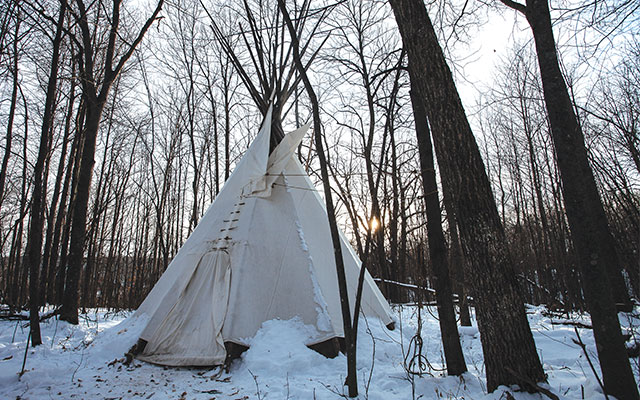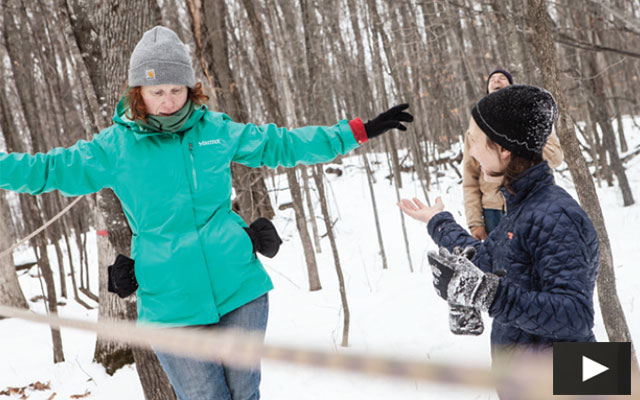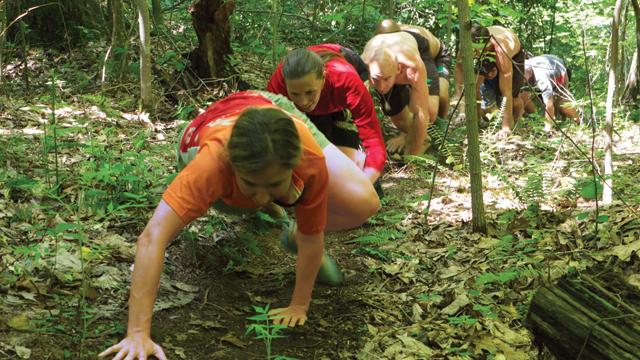My legs, wrapped around a limbless tree trunk, ache. My gloved hands clumsily fumble along the ridged bark, searching for a protrusion to grab ahold of. I want to climb higher. But, for now, I’m stuck, balancing precariously without a foothold. There’s a lesson here, I think: Stability doesn’t appear just because I want it.
I pause to let this sink in, sucking subarctic air as I peer across the snow-covered valley. It’s late fall in western Wisconsin, and a light fog and pink dusk are settling in.
In the dwindling daylight, I spy a hawk nearby, scanning the horizon for prey as it rests, its talons rooted into its own patch of knobby bark. Suddenly, it lets go. It circles overhead then dives, spiraling toward earth. Be a hawk, I tell myself.
Be a hawk, I tell myself.
“Your right foot is just below a great spot for getting some leverage!” The encouragement from below reminds me I have no reason to fear falling — I’m safely tethered by climbing gear to one of my ReWild University instructors.
“You’re doing great!” another voice calls out, helping me refocus on what my instructors told me before I began my climb: It’s not about getting to the top; it’s about having the experience and hanging in with the present moment.
This large tree — like many things in nature — is giving me a chance to experience what scientist Wallace J. Nichols, PhD, author of Blue Mind, has called “a positive lack of control, as opposed to the lack of control we feel in our overstressed, overwhelmed lives.”
The numbness settling into my fingers and the soreness gripping my muscles persuade me that climbing three-quarters of the way up is enough. “I’m ready to come down now,” I tell the man holding the end of the rope below.
“You can just let go and we’ll catch you,” he says. I decide against this and begin to rappel down, but I push off too forcefully, lose control, and plummet downward, stopped suddenly by my instructor, an expert belayer.
On the ground, feeling the full terror of my free fall, I laugh amid tears. “I guess I wanted to fall out of the tree after all.”
Why Be Wild?
The term “rewilding” comes from the field of conservation biology. Its guiding principles, the “3 Cs” — large, protected core reserves of land; connectivity; and the presence of carnivores — were outlined by Michael Soulé and Reed Noss in a landmark 1998 article in Wild Earth magazine. Animal-rewilding advocates promote the reintroduction of large predators and other keystone species into their native habitats to create and maintain the resilient, dynamic ecosystems critical to survival.
The three Cs of animal rewilding informed the evolution of human rewilding. There’s no set of codified rules that govern the rewilding groups that have popped up worldwide in recent years, but they share an interest in spending time outdoors, reconnecting with nature, and building resiliency.
By developing skills like fire building, foraging, climbing, canning, and beekeeping, participants hark back to a time when humans were more closely connected to the land.
ReWild University, near Menomonie, Wis., is one of a handful of places in the United States where rewilding is just beginning to take hold. Across the Atlantic, the concept has a larger following and a more ambitious agenda.
Rewilding Europe, a Netherlands-based nonprofit, has adopted an unofficial counterpart to the “3 Cs.” The group’s principles tidily (if somewhat obliquely) sum up the priorities of human rewilding efforts worldwide: planet, people, and prosperity. In other words, rewilding can be seen as a holistic approach to living that focuses on “prosperity” — defined, in this context, as health and well-being for people and the planet.
“Rewilding isn’t about trying to revert to living as hunter-gatherers,” says ReWild University cofounder Kenton Whitman. “It’s about examining cultural paradigms to see how they affect our physical, mental, and emotional health.”
If rewilding seems like an amorphous concept, that’s because it is. To understand it requires that we ask a better question: Why be wild?
Student-turned-instructor Nicholette Routhier of Blue Lake, Calif., found her way to ReWild University because she wanted simply to engage more with nature.
More complicated forces brought San Francisco native Brett Harris to the Wisconsin woods. Rewilding, he says, “goes beyond living healthy, breaking bad habits, or getting back in touch with nature.” After a stint working in the tech industry, Harris began looking for ways to connect to something more meaningful than consumerist ideals.
You don’t have to adopt a permanent lifestyle shift to benefit from rewilding courses (see “Rewild Yourself” below). There are half- and full-day courses for groups or individuals geared toward students of all ages. Most programs are designed to improve individual self-reliance, as well as to teach people to work together cooperatively.
There also are individual courses — like the “metamorphosis retreat” I attended at ReWild University — offering a dizzying array of experiences. Students can spend a night, a weekend, a week, or nearly a year outside, learning from and testing themselves in nature.
They get personalized, mentor-based training in survival skills, homesteading, primal fitness, and mindfulness practices designed to deepen their experience and change their lives.
Lodging varies by location. Some schools offer retreat-center-style bunks or private rooms. ReWild University offers a teepee, a yurt, or — for a more extreme outdoor experience — a hut made of grasses, leaves, and sticks. I choose the cozy confines of the yurt as my abode, and marvel as Routhier recounts tales of her nights sleeping sans shelter, experiences she says unraveled her notion of security.
Wild Fears
At the heart of rewilding is overcoming the concepts of safety and convenience that we’ve learned from what Whitman calls the “domestication process.”
“When wild animals are domesticated, distinctly unnatural behaviors develop,” he explains. “Humans are born with innate behaviors and senses, and the further we get from them, the more we feel and demonstrate the consequences of domestication, such as feelings of chronic stress, self-loathing, and preoccupation with success.”
Courses at the Oregon-based ReWilding Retreats focus on a different aspect of domestication. Instructor Nissa Howard tells me that the women-only experiences are designed to help participants “step out of their lives briefly to remember who they were before conditioning or trauma, with the intention of bringing that greater awareness back into daily life.”
Some rewilding leaders, including Whitman, use the natural landscape to present students with physical challenges. These can offer opportunities for transformation by connecting a student’s fears — like drowning and heights — with more positive traits like curiosity and adventurousness.
“Our fears keep us stuck in jobs that don’t inspire us,” Whitman explains. “Exploration inspires us to start our own business, pursue dreams, and find ways to fill our days with activities that enrich ourselves, our families, our friends, and our communities.”
To help someone face his or her fear of water, for instance, Whitman and the student fashion “snorkels” from a piece of hollow reed, which the person breathes through while submerged in a stream. “This is all done at the student’s comfort level. It’s essential to allow someone to find his or her own way from fear to curiosity,” Whitman says. “That’s when lasting change can happen.”
This type of change happened for me during a tree-vaulting exercise. I felt uneasy as Whitman led me to a waist-high fallen log and showed me how to run up to the log, stop, hop up, and land on the log with feet flat — like a box jump — and then hop down on the other side.
He did this with the effortless grace of a gymnast. My brain insisted this running–stopping–jumping motion was designed solely to injure me. After gingerly completing the task, I asked Whitman, “Wouldn’t it be simpler to just keep moving over the log?”
“Try it,” he said.
I did. More confidently each time.
The exercise taught me that telling myself that something would be difficult actually made it difficult, and it gave me a chance to complete the challenge in my own way — making it more fun.
Helping students reclaim their innate sense of joy is a fundamental part of the rewilding process. Preconceived notions prevent us from being vulnerable enough to fully enjoy the kind of play that filled our lives as children. By encouraging playful fitness endeavors, such as nature-based parkour, rewilding students have fun while developing functional strength and agility.
Rewilding isn’t a return to childhood or to a new sense of wildness; it’s a reckoning of human nature with physical nature. It teaches us to stop controlling, stop fearing.
By getting in touch with our wild hearts, by discovering what sparks our joy and passions as well as our fears and frustrations, we can make choices that nourish every part of our lives.
Rewild Yourself
Not ready to run into the wild? There are plenty of other ways to rewild yourself — even from the comfort of your own backyard.
- Climb a tree.
- Sleep outside — with or without a tent.
- Stand in the rain, face the sky, and feel the drops as they hit your face.
- Taste your food with your eyes closed.
- Question consumerism.
- Grab some friends and play tag in a park amid a grove of trees.
- Do a parkour-based workout in a local park.
- Build a fort out of things in your yard.
- Plant a tree or garden.
- Take a class that builds resiliency skills like canning, cooking, beekeeping, gardening, or foraging.
- Do some bird watching or animal tracking.
- Go for a walk in your bare feet or walk outside at night.
- Learn about wild edibles and add one to your plate.
- Find a place of natural beauty and open your five senses, one at a time.
- Take a cold shower.
- When you’re feeling rushed, stop, and take three deep breaths.
Where to Get Wild
ReWild University, Menonomie, Wis.
These “wild-life” advocates teach an array of courses designed to empower individuals and communities to live more holistically with nature.
Rewild Portland, Portland, Ore.
With workshops designed for adults or children, these folks are out to prove that you don’t need to leave the city to get wild.
ReWilding Retreats, Oregon
These women-only retreats offer a safe space where students can tap into their wild self — the self that existed before conditioning or traumas tamed it.
This originally appeared as “A Walk on the Wild Side.”




This Post Has 0 Comments